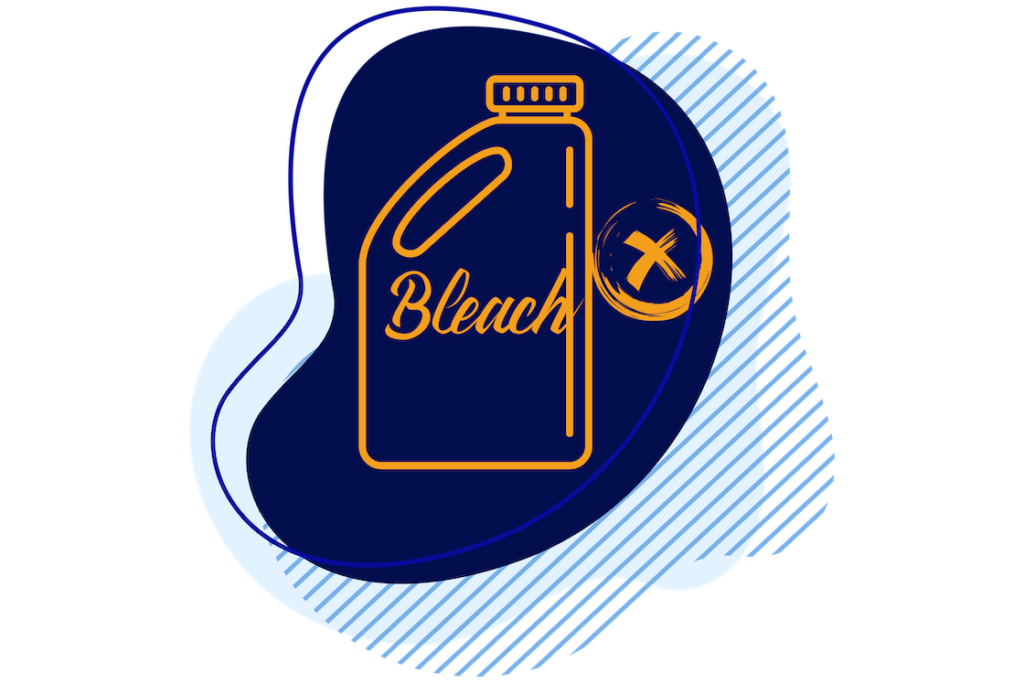Bleach is a general name for chemical products used to disinfect surfaces or remove color and stains from certain fabrics. Bleach is usually a highly diluted solution of sodium hypochlorite, and is typically 90-95 percent water. Bleach is acceptable for mold removal is a limited number of cases, but there are much better mold removal solutions available. Bleach should never be used to clean or kill mold on porous surfaces, such as walls, cabinetry, wood panels, flooring, couches, and fabrics.

Despite its wild popularity, bleach is generally one of the worst substances to use for “killing,” cleaning, or removing mold, particularly on porous items such as wood, drywall, and other building materials.
If you must use bleach or have no other alternatives, bleach should only ever be used on truly non-porous surfaces—that means the inside of porcelain toilet bowls and bathtubs, and on metal surfaces like appliances and sinks.
According to the CDC, bleach or dish detergent can be used to clean up mold in a home after a storm. “After a hurricane, flood or other major storm, “green” products can be difficult to find. Bleach and dish detergent might be the only things available in your area. Bleach and dish detergent, common household items, can be used to clean mold in your home after a storm. The steps to take to clean up mold will depend on how much water damage your home suffered.”
According to the EPA, the use of bleach is not recommended as a routine practice during mold cleanup, but there might be instances when professional judgment indicates bleach is the right product to use.
NORMI, the National Organization of Remediators and Microbial Inspectors, calls suggestions to use bleach in mold clean-up or removal one of the most widely-publicized myths, and the worst possible choice of product: “when you are faced with a wall covered in mold, bleach is NOT the product to use,” writes NORMI Executive Director Douglas Hoffman.
• Bleach, as it’s normally used, only lightens the surface of mold and hides mold stains. It covers up a mold problem.
• Bleach is 90-95 water. Water encourages mold growth.
• The active ingredient in bleach (sodium hypochlorite) evaporates rapidly, leaving mostly water behind, which seeps deeper into most surfaces (and thus feeds mold.)
• This natural evaporation makes even bottled bleach less and less effective over time.
• Bleach is toxic. There are better products to use when dealing with mold, especially if children are in the home.
Most bleach sold in stores is made up of 90-95 percent water, and 5-9 percent sodium hypochlorite. When bleach is applied to porous surfaces, such as walls, wood, couches, tile grout, and more, most of the sodium hypochlorite evaporates quickly, while the water seeps more deeply into the surface.
Water is going to encourage mold, yet if bleach is used, water is the main substance being left behind when bleach is used to clean or kill mold on porous items.
This evaporation actually happens so quickly that the longer bleach is kept for after it is first purchased and open, the more and more diluted it gets: What is evaporating is the part of the bleach that would have an impact on your home’s mold growth. Left behind, even in a closed bottle, is a higher and higher concentration of water.
Thus the CDC also advises that if you are going to use bleach even to clean or disinfect parts of your home, that you, “Make a new diluted bleach solution daily. Bleach solutions will not be as effective after being mixed with water for over 24 hours.”
Bleach is also not the most natural product to use, and is typical considered toxic. There are better and safer products to use when dealing with a mold problem.
If you must use bleach to kill or clean up mold, it should also never be mixed with ammonia, as that creates toxic and very dangerous fumes.